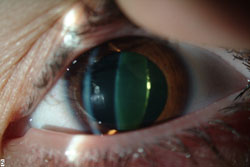 Both cataract and glaucoma surgeries are preformed in our dedicated ophthalmology operating rooms at the Rambam Health Care Campus. From the photos below you can get a glimpse of what an operating room looks like, and learn a little about the atmosphere and make-up of our operating rooms. Showing these photos is not just about curiosity. Knowing what to expect may help some of you ease the stress of entering an operating room to have your cataract or glaucoma surgery performed. In general, a familiar environment will be less intimidating than an environment which you have never encountered before. It is likely that our operating room is very different than what some patients may have envisioned.
Both cataract and glaucoma surgeries are preformed in our dedicated ophthalmology operating rooms at the Rambam Health Care Campus. From the photos below you can get a glimpse of what an operating room looks like, and learn a little about the atmosphere and make-up of our operating rooms. Showing these photos is not just about curiosity. Knowing what to expect may help some of you ease the stress of entering an operating room to have your cataract or glaucoma surgery performed. In general, a familiar environment will be less intimidating than an environment which you have never encountered before. It is likely that our operating room is very different than what some patients may have envisioned.
Briefly: both cataract and glaucoma surgeries are preformed while the patient is wearing a hospital pajama and lying on his/her back, on the operating table, face up, while a sterile bed sheet made of thick paper covers his/her face. A regular blanket covers the body. Oxygen is constantly provided during the surgery underneath the bed sheet which covers the patient’s face. Hence, the patient breathes oxygen-enriched air throughout the entire surgery. In addition, blood pressure and heart rate pulse are monitored routinely throughout the surgery.
Surgery is preformed under local anesthesia, which implies that the surgery does not necessitate general anesthesia or similar maneuvers. This anesthesia is provided via eye drops, so even a numbing injection is not required. Hence, patients should not fear the anesthesia part of the surgery, since there is no pain involved in initiating anesthesia. During the surgery, the patient is entirely awake and can hear the conversations going on in the operating room, including dialogs between the surgeon and the operating room staff as well as instructions given by the surgeon to the patient. The patient can speak what’s on his/her mind if anything is troubling or bothering him/her during the course of the surgery.
Many of my patients who have had surgery describe the stay in the operating room as an interesting experience and often very different than what they thought it might be like. The majority of patients describe the atmosphere within the operating room as relaxing and pleasant (…as can be), considering the fact that you are about to undergo eye surgery. The awareness that a very familiar doctor is right beside them at all times, performing for them a delicate procedure, and that they can speak to me at any point in time, if necessary (such as: for more anesthesia, to know if the case is already finished, etc.) is a calming factor for the patient. Most important, such atmosphere and reassurance helps achieve the very best possible outcome for that surgical procedure.
When patients who have been operated in my operating room on are asked about their experience during surgery, most reply that “it was actually far less troubling or stressful than we thought it would be”, and most admit that if they were aware of this ahead of time it would have saved them a lot of worrying and speculating about the actual surgery experience.
In conclusion, both cataract and glaucoma surgeries are performed using the most up-to-date equipment and techniques, minimizing discomfort, are performed under topical anesthesia (implying that the patient is fully awake, and only eye drops are used to anesthetize the eye). Most cases take under 30 minutes, and the vast majority of patients leave the operating room with a smile, and most important, with a sense of relief, stating that the experience was far less than they originally feared.













